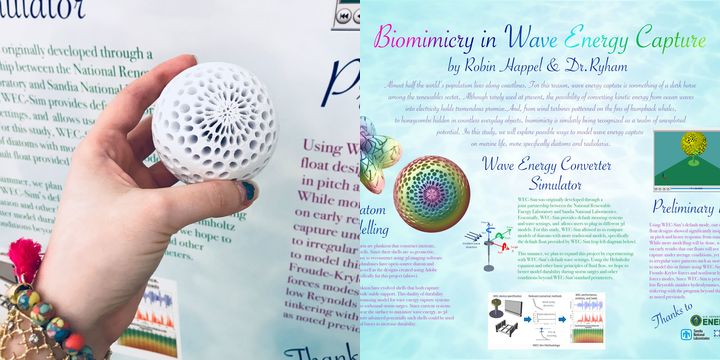Biomimetic Wave Energy Capture
The Problem
By 2050, there could be more plastic than fish in the ocean by weight. Already, half of sea turtles and almost 90% of seabirds consume plastic in their lifetimes, and many marine mammals die as a result of plastic debris and other pollution. The expansion of offshore drilling also poses a major challenge to coastal habitats, especially as the Well Control Rule and other critical safety measures are potentially being rolled back. In order to counter offshore drilling, the conservation community needs to offer an alternative way to power coastal communities, one that is both renewable and resilient.
Our Proposal
This project seeks to make wave energy capture more commercially viable by increasing resilience to storm surges. In modeling the outer shell of wave energy capture devices on diatoms and other plankton that evolved to endure the ocean current, we hope to make wave energy devices more durable. Additionally, this project seeks to incorporate passive collection of plastic to help limit the proliferation of marine debris in coastal ecosystems. By incorporating a system of surface-level drift nets into the mooring, we hope to gradually gather and contain plastic that is carried towards shore by ocean currents. Such a system would, ideally, also have minimal impacts on marine life through the use of turtle extruder devices and other established methods of allowing marine life to pass through unharmed. Additionally, we would like to incorporate a way to filter out microplastics if possible, in partnership with other researchers working on ways to filter out small particles using electrostatic screens. Using wave energy capture as an energy source could potentially help such screening become more scalable.
We Assume that...
We assume that computer modeling and small-scale prototypes of our diatom-based device housing designs are applicable to real world conditions, or can later be modified adequately.
We assume that passive plastic capture can potentially strengthen rather than weaken our current mooring plan (this, too, requires further testing).
We assume that filtering microplastics will become a progressively more mainstream approach to eliminating ocean plastics, making it potentially less expensive to fill current technological gaps.
Constraints to Overcome
Making wave energy capture systems durable during storm surges is a sizable hurdle, one which we believe can be solved with more modeling and testing. There is only so far that mathematical models like WEC-Sim can go, however, so we plan to eventually transition to physical prototypes, and are working on small-scale 3d printed models of some of our shell designs. Currently, I have a funded research grant from Fordham to conduct studies using an accelerometer and miniature wave tank.
Current Work
Eventually, we would like to provide an alternate model for powering coastal communities, one that - unlike offshore oil and gas - alleviates rather than contributes to climate change. We would also like to harness the power of coastal currents to help save shorelines current drowning in plastic pollution.
Current Needs
Funding for the prototyping stage would be very useful, as would additional technical expertise on filtration of microplastics.
